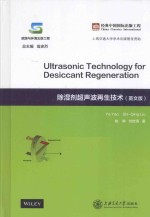图书介绍
除湿剂超声波再生技术 英文版pdf电子书版本下载

- 姚晔,刘世清著 著
- 出版社: 上海:上海交通大学出版社
- ISBN:9787313108678
- 出版时间:2014
- 标注页数:311页
- 文件大小:38MB
- 文件页数:333页
- 主题词:防潮剂-超声波处理-英文
PDF下载
下载说明
除湿剂超声波再生技术 英文版PDF格式电子书版下载
下载的文件为RAR压缩包。需要使用解压软件进行解压得到PDF格式图书。建议使用BT下载工具Free Download Manager进行下载,简称FDM(免费,没有广告,支持多平台)。本站资源全部打包为BT种子。所以需要使用专业的BT下载软件进行下载。如 BitComet qBittorrent uTorrent等BT下载工具。迅雷目前由于本站不是热门资源。不推荐使用!后期资源热门了。安装了迅雷也可以迅雷进行下载!
(文件页数 要大于 标注页数,上中下等多册电子书除外)
注意:本站所有压缩包均有解压码: 点击下载压缩包解压工具
图书目录
1 Introduction 1
1.1 Background 1
1.2 Literature Reviews 2
1.2.1 Desiccant Materials 2
1.2.2 Types of Desiccant Dryer 4
1.2.3 Regeneration Methods 10
1.3 The Proposed Method 19
1.3.1 Basic Knowledge about Ultrasound 19
1.3.2 Sound Generation 22
1.3.3 Fundamental Theory for Ultrasound-Assisted Regeneration 24
1.4 Summary 26
References 26
2 Ultrasound-Assisted Regeneration of Silica Gel 33
2.1 Theoretical Analysis 33
2.2 Experimental Study 38
2.2.1 Experimental Setup 38
2.2.2 Procedure for Experiments 39
2.2.3 Methods 40
2.2.4 Results and Discussions 42
2.3 Empirical Models for Ultrasound-Assisted Regeneration 51
2.3.1 Model Overviews 51
2.3.2 Model Analysis 52
2.4 Theoretic Model for Ultrasound-Assisted Regeneration 59
2.4.1 Physical Model 62
2.4.2 Mathematical Model for Ultrasonic Wave Propagation 62
2.4.3 Mathematical Model for Heat and Mass Transfer in Silica Gel Bed 67
2.4.4 Model Validation 75
2.4.5 Error Analysis for Experimental Data 85
2.5 Parametric Study on Silica Gel Regeneration Assisted by Ultrasound 89
2.5.1 Acoustic Pressure and Oscillation Velocity in the Packed Bed 89
2.5.2 Thermal Characteristics of the Bed during Ultrasound-Assisted Regeneration 91
2.5.3 Enhancement of Regeneration Assisted by Ultrasound 106
2.5.4 Comparisons between the Transverse-and Radial-Flow Beds 110
2.6 Quantitative Contribution of Ultrasonic Effects to Silica Gel Regeneration 110
2.6.1 Theoretical Analysis 110
2.6.2 Method 113
2.6.3 Results and Discussions 114
2.7 Energy-Saving Features of Silica Gel Regeneration Assisted by Ultrasound 119
2.7.1 Specific Energy Consumption 119
2.7.2 Results and Discussions 120
2.7.3 Brief Summary 125
2.8 Effects of Ultrasound-Assisted Regeneration on Desiccant System Performance 126
2.8.1 Study Objective and Method 126
2.8.2 Results and Discussions 127
2.8.3 Brief Summary 139
References 139
3 Ultrasound-Assisted Regeneration for a New Honeycomb Desiccant Material 141
3.1 Brief Introduction 141
3.2 Experimental Study 142
3.2.1 Experimental System 142
3.2.2 Raw Material and Experimental Conditions 142
3.2.3 Analysis Parameters 144
3.2.4 Experimental Results 145
3.2.5 Energy Attenuation and Absorptivity of Ultrasound in the Material 154
3.3 Theoretical Model for Honeycomb-Type Desiccant Regeneration 159
3.3.1 Basic Assumptions 159
3.3.2 Governing Equations 159
3.3.3 Determination of Key Parameters 160
3.3.4 Model Validation 161
3.4 Model Simulations and Analysis 163
3.4.1 Parametric Study 163
3.4.2 Quantitative Contributions of Ultrasonic Effects to the Regeneration of Honeycomb-Type Desiccant 172
3.5 Summary 176
References 176
4 Ultrasound-Atomizing Regeneration for Liquid Desiccants 177
4.1 Overview 177
4.1.1 Principles and Features of the Liquid-Desiccant Dehumidification 177
4.1.2 Thermo-Physical Properties of Liquid Desiccant Materials 178
4.1.3 Research Status of Solution Regenerators 182
4.2 Theoretical Analysis 183
4.2.1 Mass Transfer Coefficients for the Droplets 183
4.2.2 Atomized Size of Droplet by Ultrasonic Atomizing 192
4.2.3 Droplet Distribution Characteristics and Measurement Techniques 194
4.2.4 Vapor Pressure of Liquid Desiccant Mixture 196
4.3 Theoretical Modeling for the Ultrasound-Atomizing Regenerator 201
4.3.1 Assumptions 201
4.3.2 Basic Equations 201
4.3.3 Determination of Key Parameters 202
4.3.4 Model Validation 203
4.3.5 Parametric Study 208
4.4 Performance Analysis of Liquid-Desiccant Dehumidification System with Ultrasound-Atomizing Regeneration 221
4.4.1 The Ultrasound-Atomizing Regenerator versus the Packed One 221
4.4.2 Performance of Liquid Desiccant System with Different Regenerators 226
References 233
5 Ultrasonic Transducers 235
5.1 Longitudinal Vibration of Sandwich Piezoelectric Ultrasonic Transducer 235
5.1.1 Overview 235
5.1.2 Theoretical Analysis 240
5.1.3 State Equations of Sandwich Piezoelectric Electromechanical Transducer 248
5.1.4 Design Case 256
5.2 Radial Vibration Ultrasonic Transducer 258
5.2.1 Overview 258
5.2.2 Theoretical Analysis and Design of a Binary Radial Transducer 259
5.2.3 Radial Vibration Sandwich Piezoelectric Transducer 267
5.2.4 Summary 275
5.3 Ultrasonic Atomization Transducer 275
5.3.1 Basic Principle of Ultrasonic Atomization 275
5.3.2 Basic Structure of Ultrasonic Atomizers 275
5.3.3 Research Status and Applications 277
References 281
6 Desiceant System with Ultrasonic-Assisted Regeneration 283
6.1 For Solid-Desiccant System 283
6.1.1 Based on the Longitudinal Vibration Ultrasonic Transducer 283
6.1.2 Based on the Radial Vibration Ultrasonic Transducer 284
6.2 For Liquid-Desiccant System 287
6.3 Future Work 289
6.3.1 Development of Ultrasonic Transducer 289
6.3.2 Development of Desiccant Materials Adaptive to Ultrasound-Assisted Regeneration 290
6.3.3 Development of Demister 290
6.3.4 Environmental Impact 290
References 292
Appendix A Basic Equations for Properties of Common Liquid Desiccants 293
A.1 Lithium Chloride(LiCl) 293
A.2 Calcium Chloride(CaCl2) 297
A.3 Lithium Bromide(LiBr) 299
A.4 Vapor Pressure(Pa) 302
A.5 Specific Thermal Capacity(J/(kg·°C)) 303
A.6 Density(kg/m3) 303
A.7 Dynamic Viscosity(Pas) 303
References 306
Index 307